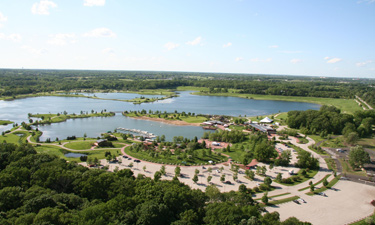 Quarries are everywhere. The construction industry’s insatiable need for sand, gravel, and stone for roads, buildings, and landscaping keeps the extraction industry constantly digging holes in the ground and taking huge bites out of hillsides from coast to coast. Communities grow right around them. Little-used quarries become hidden behind fences and walls.
Quarries are everywhere. The construction industry’s insatiable need for sand, gravel, and stone for roads, buildings, and landscaping keeps the extraction industry constantly digging holes in the ground and taking huge bites out of hillsides from coast to coast. Communities grow right around them. Little-used quarries become hidden behind fences and walls.
In recent years, parks and recreation agencies and municipalities have been discovering these often hidden resources and turning them into popular recreation facilities—initiatives which can drive community economic development and constituent support for years. The time and money spent on quarry redevelopment projects creates recreation spaces that communities love and appreciate.
A good example is Centennial Beach in Naperville, Illinois, a pool with a sandy beach that has been the community swimming hole for more than 80 years. Centennial Beach is not only a beloved part of the community; it is also a component of Naperville’s bustling downtown.
The historic Quincy (Massachusetts) Quarries near Boston provided the stone for three centuries of Boston structures including Bunker Hill Monument. In 1985, the Boston Metropolitan District purchased 22 of the quarries’ acres, and created the Quincy Quarries Reservation. The (in)famous Boston Big Dig project contributed dirt to fill the quarries. Today, the Massachusetts Department of Conservation and Recreation operates the facility which attracts climbers from across North America and hikers from the local community.
Almost 20 years elapsed from the time Vulcan Materials stopped operations of a sand and gravel quarry in the City of Crystal Lake, Illinois, to the opening of the city-owned Three Oaks Recreational Area. In its first three months of operation, even without the planned swimming facilities open, some 18,000 people visited for boating, water sports, fishing, or a walk or run. There’s just enough land around the site—between water’s edge and a state highway—for condo and commercial development that is still expected despite being slowed by the recession.
Near Hartford, Connecticut, Brownstone Exploration and Discovery Park, a privately operated extreme adventure park, was built in a former quarry leased from the Town of Portland. Portland receives a portion of gate receipts and is relieved of much of the maintenance and policing, and its residents use the park for half price. Experiences include cliff jumping, rock climbing, swimming, kayaking, scuba diving, climbing and rappelling, wakeboarding, and zip-lining.
Until 1999, what is now the 1,100-acre Independence Grove in Libertyville, Illinois, was an active sand and gravel quarry. Planning began in 1980 by the Lake County Forest Preserve District (LCFPD), well before quarry operations ceased, and the district purchased the property. The LCFPD was planning and designing building improvements, including revenue-producing and educational facilities for a recreational reuse, even as mining operations wound down.
The mine operator became a critical partner—by providing a significant income stream from the lease agreement as well as grading for new infrastructure. LCFPD added roads, and the mine operator built trails and sewer lines and contributed top soil and seeding. The $24-million Independence Grove opened in 2001. Today, the quarry-turned-adventure park attracts an estimated two million visits annually for water sports, the trail system, picnicking, education programs, special events, boating, fishing, and swimming.
San Antonio, Texas, is famous for its quarry re-uses. Some of its limestone quarries have become a multi-use development—including two golf courses, a Six-Flags theme park, two large shopping centers, the San Antonio Zoo, and the city’s Japanese Botanic Gardens, the last two in the city’s famous Brackenridge Park.
As quarry redevelopment can take years, it is wise to engage the operating owner to begin planning while the facility is still active. Their good records can help inform plans and identify issues. With their equipment already in place, the quarry operator can help prepare the landscape for its next use. The actual quarrying equipment can be costly to move and, alternately, can become fun and amusing additions to the re-use plan.
Most quarries available for redevelopment are already closed. Obtaining historical data for planning can be challenging. The upside is that a park agency acquiring a closed quarry can begin redevelopment on its own schedule.
Many possibilities lie ahead for unused and soon-to-close quarries. The U.S. landscape – especially near rivers and canals – is pockmarked with thousands of quarries. New recreational facilities, especially in larger quarries, can offer communities unique landscapes with changes in elevation, rocky outcrops, and freshwater courses and features.
Dan Martin and Helene Berlin are principals with Market & Feasibility Advisors, LLC.

